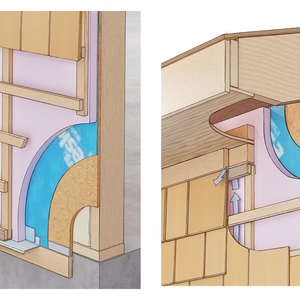I have spent most of this holiday weekend redoing our shower. Nothing fancy. New valve and a plastic (polystyrene?) surround.
Anyways, I got the valve installed and turned on the water to check for leaks.
There are two leaks. Both are at the threads between the valve body and the female adaptor. One leak at the hot water line, one at the cold water line.
I’m not a plumber, but I’ve done such connections plenty of times and I have rarely had a problem. I was extra careful this time knowing that there would be no opportunity to tighten the fitting once it was installed. I used teflon tape (several windings) and wenched it on good and tight.
I suspect the fitting quality for two reasons. The first being that they both leak. The second being that of the four fittings I bought, one of them had no threads! I had to exchange it.
Oh, and since I did this on a holiday weekend and didn’t really plan ahead, the fittings are from Home Depot.
So tomorrow I get to cut the thing out and redo it with fittings from the hardware store.
Rich Beckman
This signature line intentionally left blank.




















Replies
Possibly imported components of questionable quality in thread design control during manufacture from what i have read here on BT previously.
I use to work with a plumber that always in addition to Teflon tape would add plumber's putty as there was no profit in callbacks.
Said he had only had two callbacks for leaks of that nature after years of being a fulltimer.
be two cents from a two center
http://www.quittintime.com/
" G@D DAMN IT RICH! CAN YOU PLEASE SHUT the F UP!" Riverfest 2005
"There are two leaks. Both are at the threads between the valve body and the female adaptor. One leak at the hot water line, one at the cold water line. .... I used teflon tape (several windings) and wenched it on good and tight."
I'm not a plumber either...but have installed a few shower mixing valves.
Rich, the adaptor you screwed to the valve body, did it screw into a threaded recess machined into the body, or onto a threaded protuberance from the valve body?
If a recess, the adaptor should be a MIP (male iron pipe) brass threaded fitting, tefloned and screwed into the valve body. If a protuberance, then a FIP (female iron pipe) fitting makes the connection, but I've never seen this last config. Note: the fittings are brass...iron is just the term used.
Normally, valve bodies have threads cut into them, therefore, the connection is with a brass MIP fitting. The other end of this fitting is configured to receive either a PEX or copper supply pipe. If copper, the usual procedure is to solder the copper (normally a short section) onto the MIP fitting before tightening it into the valve body threads. Valve bodies can be damaged by heat unless their guts are first removed.
Though leaks at the MIP/valve body can occur because of mfg. defects in the casting or machining, they usually occur when the MIP is overtightened....the valve body develops a hairline crack in the threaded area.
Edit: like rez sez, adding pipe dope to the connection, with new teflon (the thick orange stuff, not the thin white teflon) might correct the leak if the fitting is defective and the valve body is not cracked.
Edited 1/1/2007 6:54 pm ET by Pierre1
"the adaptor you screwed to the valve body, did it screw into a threaded recess machined into the body, or onto a threaded protuberance from the valve body?"Since it was a female adaptor, it threaded onto a protuberance from the valve body. This is a Kohler valve.
"If a protuberance, then a FIP (female iron pipe) fitting makes the connection, but I've never seen this last config. Note: the fittings are brass...iron is just the term used."I'm sure I have the correct fitting. It screwed on very smoothly with no play.I'll probably add the plumbers putty, but if I have to take this apart, I'll be damned if it goes together again with fittings from the Depot.
Rich BeckmanThis signature line intentionally left blank.
Kohler: is that a US or a Euro manufactured valve?
Rather than plumber's putty, use pipe dope, which comes in a tube or a small can with built-in brush.
Putty is best used to set drains, or toilet valves... things that are not subject to full supply line pressure.
well ya, that was the intention of the comment.
Forgive my lack of attentiveness to that small but important detail.
http://www.quittintime.com/
" G@D DAMN IT RICH! CAN YOU PLEASE SHUT the F UP!" Riverfest 2005
that's what I thought rez. Rich prolly knows it too.
Differentiating for those who might not.
LOL!!Yeah, yeah. Pipe dope. I know.I simply typed what I had just read without thinking about it.But I would've never tried to use plumber's putty for that application!!!
Rich BeckmanThis signature line intentionally left blank.
Yea Pierre was correct I very seldom use plumbers putty. I dont use pipe dope much
Have ya tried tape. I usually use just one wrap then tighten it.
View Image Official Jeff Buck Memorial Tagline "
Edited 1/4/2007 9:54 am by Sancho
"Have ya tried tape. I usually use just one wrap then tighten it."Yes. Tape is what I always use. I think I used too much this time.Although I still suspect the fittings. I noticed that the fitting went all the way on. Another half turn and there would have been no threads left. I don't think I've ever seen that. (And, yes, I wrenched it on good, but that means holding the valve in one hand and the 10" wrench in the other, awkward at best.) Then a half turn to loosen and I didn't need the wrench to finish removing it.Other interesting things on this job:The bathtub spout from Kohler just slips over the copper stub and then is locked on with a set screw. There is an O ring to seal the connection. The instructions specifically say CAUTION that petroleum-based lubricant should not be used to ease the fit. But the directions on the CD-Rom specifically say to use petrolum jelly to east the fit.I used nothing.The surround calls for six tubes of adhesive applied with a 1/4" v notched trowelI've run into this before and I'm still confused about two things.The directions also call for full coverage. I have no idea how that is accomplished. I believe I used ten tubes and I still didn't have 100% full coverage.If the adhesive is to be troweled, why can't it be purchased in a gallon instead of in tubes?
Rich BeckmanThis signature line intentionally left blank.
> The instructions specifically say CAUTION that petroleum-based lubricant should not be used to ease the fit. But the directions on the CD-Rom specifically say to use petrolum jelly to east the fit.Oddly, petroleum jelly (petrolatum) isn't classified as a "petroleum lubricant". That classification would apply to stuff like auto grease.But if you want to be doubly sure you should use a silicone plumber's grease.
Half of the harm that is done in this world is due to people who want to feel important. They don't mean to do harm but the harm does not interest them. --T.S. Eliot
Well, there is a mystery solved. Thanks.The written instructions do OK a silicone based lubricant (or soapy water).
Rich BeckmanThis signature line intentionally left blank.
Rich, You are not alone.I recently installed a faucet from said store and water flowed from every part except the one it was supposed to.When explaining my problems to a plumber friend of mine he just burst out laughing.
I hate to say this, but I would bet you cracked the valve thread casting by tightening it too much. I can't tell you how many times I have seen this problem.
It could be bad fittings, but when you use teflon tape & "wrench it on" good and tight there is a very good chance you are going to crack the valve body thread housing.
Oooppps...I didn't notice that you said it was a female adapter. However, the above warning applies to most new valves. That's a common problem.
Edited 1/1/2007 8:50 pm ET by BoJangles
Same deal though, only the FIP adaptor is the one that may be cracked.
That's true...at least it's not as expensive to fix! This is why I like to solder them in.
Did I miss something? What kind of pipe are you using? If it is the cpvc female adapters then they are very pretty prone to cracking or deforming if honked down a little too much. Lowes has some brass to cpvc transitions that I have never had a problem with. They also have ones that have a ring and standard transition that can function like a union.
Also the cpvc females I have seen have an o-ring at the bottom. With those I believe you do not use tape. I use the pipe dope, White Seal, RectorSeal, or equiv. I do not really like them because I have taken some out where the the o-ring has deteriorated.
But I am not a plumber.
"Did I miss something? What kind of pipe are you using?"The valve is brass. The pipe is copper. The fitting is...? The pipe is soldered to the fitting, then the fitting was screwed to the valve. Then the assembly was soldered to the existing pipes.No cpvc or pvc or pex, etc. Just copper and brass.
Rich BeckmanThis signature line intentionally left blank.
Thanks, I did not see anything about any material other than the mix valve.
Tis a poor workman that blames his fittings. ;)
Hard to say. Could have been the fittings, the valve, too much teflon (two wraps is generally better than four), the phase of the moon. You could have overtightened the fittings and cracked the valve.
I have experienced HD pipe adapters that leaked no matter what I did. Until I replaced them with units from my local hardware store. Then the problem just went away.
So I put a micrometer on the HD stuff, which turned out to be .005 to .015 smaller than their replacements.
Just can't beat that Chinese quality control.
Many years ago I had a similar "weekend" problem with a brass fitting (from Sears, IIRC) that had a defect in the casting, allowing it to "weep".
Half of the harm that is done in this world is due to people who want to feel important. They don't mean to do harm but the harm does not interest them. --T.S. Eliot
Ah Ha!!!And I was just going to post an admission that I probably screwed it up with too much teflon tape and here you are admitting it could indeed be the fitting!I don't remember how much tape I put on, but I can easily imagine that I got carried away with it.When I took it apart, the tape was not in the threads at all, just piled up at the end of the thread more or less.I can't see any evidence that the fitting cracked.I redid it with fittings from the hardware store using tape and dope and there are now no leaks.
Rich BeckmanThis signature line intentionally left blank.
Geez Rich, now we'll never know.
;)
Yeah, he should take it apart again and reasemble with the old fittings, just to see.
Half of the harm that is done in this world is due to people who want to feel important. They don't mean to do harm but the harm does not interest them. --T.S. Eliot
"Yeah, he should take it apart again and reasemble with the old fittings, just to see."LOL!!!Damn! I wish I'd thought of that! Not that I'd of done it. When one is as slow as me, one doesn't deliberately take such detours.
Rich BeckmanThis signature line intentionally left blank.
Just my two cents worth. I nearly always install bath fixtures with unions and shut off valves so that the next guy can replace it easier.
Why don't you just solder the pipes onto the valves? If you have to sue the fittings, solder them on too. Make sure you take the valve apart and remove anything that can be damaged by heat first though.
Unions make it a little easier, but they're also another point of failure, especially if a valve is "abused" enough to move the pipes around.
Half of the harm that is done in this world is due to people who want to feel important. They don't mean to do harm but the harm does not interest them. --T.S. Eliot
"Why don't you just solder the pipes onto the valves?"I've never heard of soldering a threaded joint.Also, I'd rather not have to start worrying about what will and what will not be damaged in the valve by the close soldering...and whether I will get it back together properly.Maybe the fitting was bad, maybe I put too much tape on it. Either way, it isn't likely to happen again.
Rich BeckmanThis signature line intentionally left blank.
I hate plumbing!
I don't want anything to do with anything I can't fix without a hammer.
Good luck with yours
Am with you on that one! Its the only way we have seen it done by the Pros in the last 15 years. Clean & flux the 1/2" pipe stick-it in the hole!
"I nearly always install bath fixtures with unions and shut off valves so that the next guy can replace it easier."The shut off valves are already there.But I would've thought that that was a code violation since they are not really accessible without putting a hole in the wall.As for the unions, I see the point, but cutting into the copper doesn't seem all that more difficult.
Rich BeckmanThis signature line intentionally left blank.
Some manufacturers have the small screwdriver slot stop valves that go on to that male part on the mix valve. It is then access. through the large cover plate. I like the ones with it incorporated like the one you have.
Bad fittings aren't unheard of. I contracted for a commercial sprinkler system to be installed 2 years ago. 10% of the fittings were defective. That equated to 100's of slow leaks throughout a large building.
It took a while, but the mfr ultimately made good and paid for the rework. Not cheap.
Ithaca, NY "10 square miles, surrounded by reality"